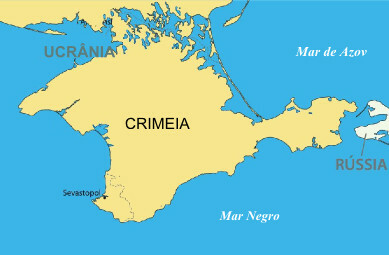Crimea is a semi-autonomous province of Ukraine located in the southern region of the country, on a peninsula on the shores of the Black Sea. It is an area that, despite being part of the Ukrainian territory, still has strong relations ethnic and political issues with Russia, being one of the main barriers between the two countries in terms of diplomatic.
The main strategic value of Crimea is undoubtedly its geographical position. The region represents an important outlet for the Black Sea, which is Russia's only warm-water port. This means that this zone has relevance both on a commercial and military level for the Russians, as it facilitates the cargo handling and for ensuring control of the channel that connects this sea to the Sea of Arzov, as we can see on the map. follow:

Location map of the province of Crimea
Another important point is the economic value of the province, which is a great producer of grains and wines, as well as an advanced food industry. The ports of Crimea are also responsible for a good part of the flow of Ukrainian agricultural production that goes towards the Europe and Russia itself, in addition to being the point where the country carries out a considerable part of its imports, including gas Russian.
In an agreement signed in 2010, Russia installed a military base in Sevastopol, a city located in southern Crimea, which is expected to remain in place until the year 2042. In exchange, the Moscow government provided $40 billion worth of natural gas, an energy source on which Ukraine is extremely dependent.
In addition to all these factors, the region is home to a large number of peoples linked to Russia, using the language of the neighboring country. This population corresponds to 60% of the more than two million inhabitants of the region, which was ceded to Ukraine during the Soviet Union by the leader of the Communist Party, Nikita Khrushchev. In this sense, both the Russian government and the Ukrainian government seek to intensify nationalist sentiment in the region for both sides in order to amplify local ideological influence, currently polarized between the "pro-Russia" and the "pro-Ukraine", the latter better known as "pro-Europe", as they favor a closer trade relationship with the Union European.
Do not stop now... There's more after the advertising ;)
This issue is even at the heart of crisis that has hit the country in recent times, resulting in a series of protests that toppled, respectively, Prime Minister Mykola Azarov and President Viktor Yanukovych with the institution of a new government. This change in power was a reprisal for the actions of the then president, who refused to sign a treaty that would strengthen relations. Ukrainian commercials with the European Union, preferring to approach Russia economically, which displeased the commandos pro-Europe.
Russian President Vladimir Putin then considered this takeover an illegitimate action. Thus, the Crimean region came to be dominated by a pro-Russian command, which has been seeking to expand the region's autonomy and consolidate a center of opposition to the newly installed government. Thus, under the justification of “normalizing” the situation and establishing protection for Russian citizens, Russia sent troops to Crimea, occupying airports and military bases in the province.
This movement deeply displeased Western governments, notably the European Union and the United States, which do not look favorably upon an eventual growth of Russian imperialism in the region. For this reason, US President Barack Obama has been articulating a series of diplomatic and trade sanctions against Russia to weaken Moscow and pressure Putin to retreat, which has contributed to heightening tensions both locally and at scale worldwide.
___________________________
¹ Image credits: Igor Golovniov / Shutterstock
By Rodolfo Alves Pena
Graduated in Geography
Would you like to reference this text in a school or academic work? Look:
PENA, Rodolfo F. Alves. "The strategic importance of Crimea"; Brazil School. Available in: https://brasilescola.uol.com.br/geografia/a-importancia-estrategica-crimeia.htm. Accessed on June 27, 2021.
